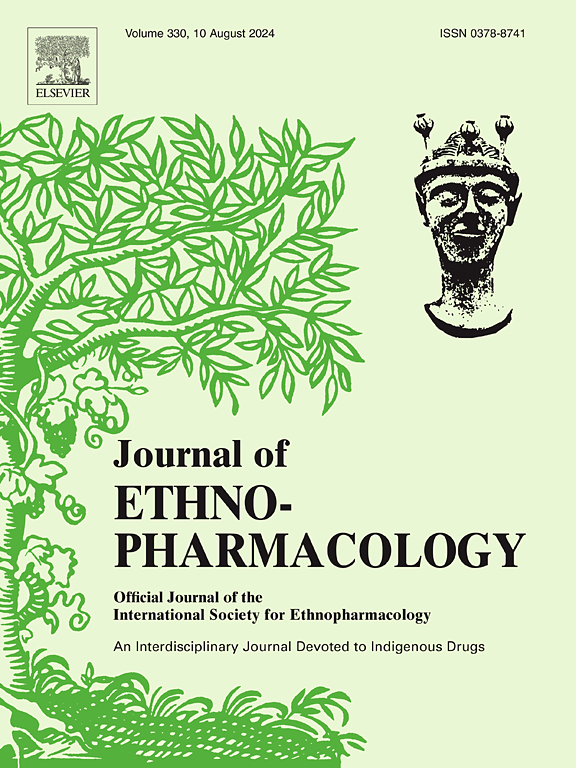Huangqin decoction alleviated irinotecan-induced diarrhea by inhibiting endoplasmic reticulum stress through activating AMPK/mTOR-mediated autophagy
IF 4.8
2区 医学
Q1 CHEMISTRY, MEDICINAL
引用次数: 0
Abstract
Ethnopharmacological relevance
Huangqin decoction (HQD), a traditional Chinese antidiarrheal formula, is effective in treating chemotherapy-induced diarrhea (CID). However, its underlying mechanism has not been fully clarified.
Aim of the study
This study aimed to determine whether the underlying mechanism of HQD against CID is related to the activation of AMPK/mTOR-mediated autophagy inhibiting endoplasmic reticulum (ER) stress.
Materials and methods
Network pharmacology was used to screen potential targets and pathways. The CID mouse model was induced by intraperitoneal injection of 75 mg/kg irinotecan consecutively for four days. The effectiveness of HQD against CID was evaluated through diarrhea score, intestinal epithelial permeability, etc. The histopathological changes of colon were evaluated by HE staining. Alcian blue and immunofluorescence staining were used to assess mucous layer and the expression of MUC2, TJP-1, Occludin, and LC3, relatively. The level of GRP78 and CHOP was assessed by RT-qPCR and WB. Furthermore, the levels of LC3II/I, Beclin-1, P62, AMPK, p-AMPK, mTOR, p-mTOR were evaluated by WB.
Results
Network pharmacology highlighted that the therapeutic effects of HQD against CID may be related to ER stress, autophagy, AMPK, and mTOR signaling pathways, etc. Subsequently, we conducted animal experiments to validate the predicted results. HQD improved CID by attenuating diarrhea, intestinal permeability, etc. HQD could effectively repair intestinal mucous barrier by activating AMPK/mTOR-mediated autophagy to inhibit ER stress.
Conclusion
Irinotecan disrupted the intestinal barrier causing diarrhea, while HQD could repair intestinal barrier via inducing AMPK/mTOR-mediated autophagy inhibiting ER stress, thereby exerting therapeutic effects against CID.

黄芩汤通过激活AMPK/ mtor介导的自噬,抑制内质网应激,减轻伊立替康所致腹泻
黄芩汤(HQD)是一种中药止泻方,对化疗性腹泻(CID)有较好的治疗效果。然而,其潜在机制尚未完全阐明。本研究旨在确定HQD抗CID的潜在机制是否与AMPK/ mtor介导的自噬抑制内质网(ER)应激的激活有关。材料与方法利用网络药理学方法筛选潜在靶点和通路。采用伊立替康75 mg/kg腹腔注射,连续4 d建立CID小鼠模型。通过腹泻评分、肠上皮通透性等评价HQD对CID的疗效。HE染色观察结肠组织病理学变化。采用阿利新蓝染色和免疫荧光染色检测粘膜层及MUC2、tfp -1、Occludin、LC3的相对表达情况。RT-qPCR和WB检测GRP78和CHOP水平。WB检测LC3II/I、Beclin-1、P62、AMPK、p-AMPK、mTOR、p-mTOR水平。结果网络药理学研究强调,HQD对CID的治疗作用可能与内质网应激、自噬、AMPK、mTOR信号通路等有关。随后,我们进行了动物实验来验证预测结果。HQD通过减轻腹泻、肠通透性等改善CID。HQD可通过激活AMPK/ mtor介导的自噬,有效修复肠黏膜屏障,抑制内质网应激。结论伊立替康破坏肠道屏障导致腹泻,而HQD可通过诱导AMPK/ mtor介导的自噬抑制内质网应激来修复肠道屏障,从而对CID发挥治疗作用。
本文章由计算机程序翻译,如有差异,请以英文原文为准。
求助全文
约1分钟内获得全文
求助全文
来源期刊

Journal of ethnopharmacology
医学-全科医学与补充医学
CiteScore
10.30
自引率
5.60%
发文量
967
审稿时长
77 days
期刊介绍:
The Journal of Ethnopharmacology is dedicated to the exchange of information and understandings about people''s use of plants, fungi, animals, microorganisms and minerals and their biological and pharmacological effects based on the principles established through international conventions. Early people confronted with illness and disease, discovered a wealth of useful therapeutic agents in the plant and animal kingdoms. The empirical knowledge of these medicinal substances and their toxic potential was passed on by oral tradition and sometimes recorded in herbals and other texts on materia medica. Many valuable drugs of today (e.g., atropine, ephedrine, tubocurarine, digoxin, reserpine) came into use through the study of indigenous remedies. Chemists continue to use plant-derived drugs (e.g., morphine, taxol, physostigmine, quinidine, emetine) as prototypes in their attempts to develop more effective and less toxic medicinals.
 求助内容:
求助内容: 应助结果提醒方式:
应助结果提醒方式:


